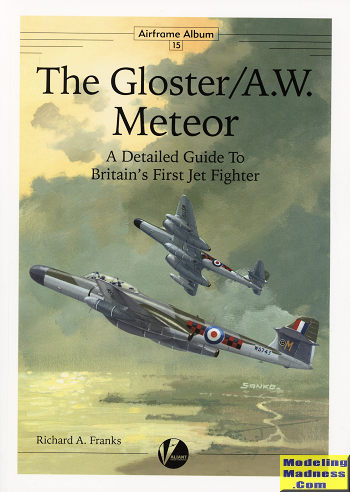 This latest
edition of Airframe Album concentrates on the Gloster and Armstrong Whitworth
Meteor. While the Germans were the first to fly a turbine powered aircraft and
the first to put them into production with the Me-262, the British were not all
that far behind. The aircraft were similar in several ways with each requiring
two wing mounted engines to provide the needed thrust. However their choice of
engine design was quite different. The Germans went with the axial flow
turbojet, which eventually became the way to do jet engines, while the British
chose the simpler centrifugal flow variant, a type that is now more used in
helicopters and small turboprops. Axial flow engines provide a smaller diameter,
but with the trade-off of greater complexity. For early jets, the choice of a
centrifugal flow meant greater reliability at the expense of greater engine
diameter.
This latest
edition of Airframe Album concentrates on the Gloster and Armstrong Whitworth
Meteor. While the Germans were the first to fly a turbine powered aircraft and
the first to put them into production with the Me-262, the British were not all
that far behind. The aircraft were similar in several ways with each requiring
two wing mounted engines to provide the needed thrust. However their choice of
engine design was quite different. The Germans went with the axial flow
turbojet, which eventually became the way to do jet engines, while the British
chose the simpler centrifugal flow variant, a type that is now more used in
helicopters and small turboprops. Axial flow engines provide a smaller diameter,
but with the trade-off of greater complexity. For early jets, the choice of a
centrifugal flow meant greater reliability at the expense of greater engine
diameter.
While the Meteor could have been put into combat in the
air to air role (it had a brief stint at ground attack), it was decided by the
RAF that they did not want the engine technology to fall into German hands.
Hindsight shows us that this was a false fear as by the time the Meteor entered
squadron service, the war was so close to being over that even if the Germans
had recovered a crashed copy, they would not have had time to copy and develop
it.
Despite its near obsolescence by the late 1940s, the
Meteor continued to be developed and became a very successful type. Thanks to
the UK's need for currency after WWII, the Meteor became the first jet fight of
many foreign air arms. Here its simplicity of design was a major plus and many
were in front line service into the 1960s with some remaining in use until the
1990s in special roles.
The book follows the usual script with a history of the
type, the different variants, close up images of extant airframe as well as
period images and tech manual drawings. There is a section on the differences
between airframes and one on the various camouflage schemes worn by the
aircraft. Needless to say, these sections are fairly extensive considering the
number of variants and sub-variants of the Meteor that were produced. The modeler's section has two builds, a 1/72
Cyber-Hobby F.1 and a 1/48 Airfix FR.9. The
usual listing of kits, decals and accessories is provided near the end. The
author rightly comments that this is not a model review book, hence a number of
other kits were not built for this edition, something I think that readers
frequently overlook.
In all, a most welcome addition to what is a superb
series of books and well worth the effort of picking up. This one is going right
into my reference library.
May 2019
Copyright ModelingMadness.com. All rights reserved.
For more on Valiant Wings, including getting this book, visit
www.valiant-wings.co.uk. Thank you
for the review copy.
If you would like your product reviewed fairly and quickly, please
contact
me or see other details in the
Note to
Contributors.
 This latest
edition of Airframe Album concentrates on the Gloster and Armstrong Whitworth
Meteor. While the Germans were the first to fly a turbine powered aircraft and
the first to put them into production with the Me-262, the British were not all
that far behind. The aircraft were similar in several ways with each requiring
two wing mounted engines to provide the needed thrust. However their choice of
engine design was quite different. The Germans went with the axial flow
turbojet, which eventually became the way to do jet engines, while the British
chose the simpler centrifugal flow variant, a type that is now more used in
helicopters and small turboprops. Axial flow engines provide a smaller diameter,
but with the trade-off of greater complexity. For early jets, the choice of a
centrifugal flow meant greater reliability at the expense of greater engine
diameter.
This latest
edition of Airframe Album concentrates on the Gloster and Armstrong Whitworth
Meteor. While the Germans were the first to fly a turbine powered aircraft and
the first to put them into production with the Me-262, the British were not all
that far behind. The aircraft were similar in several ways with each requiring
two wing mounted engines to provide the needed thrust. However their choice of
engine design was quite different. The Germans went with the axial flow
turbojet, which eventually became the way to do jet engines, while the British
chose the simpler centrifugal flow variant, a type that is now more used in
helicopters and small turboprops. Axial flow engines provide a smaller diameter,
but with the trade-off of greater complexity. For early jets, the choice of a
centrifugal flow meant greater reliability at the expense of greater engine
diameter.